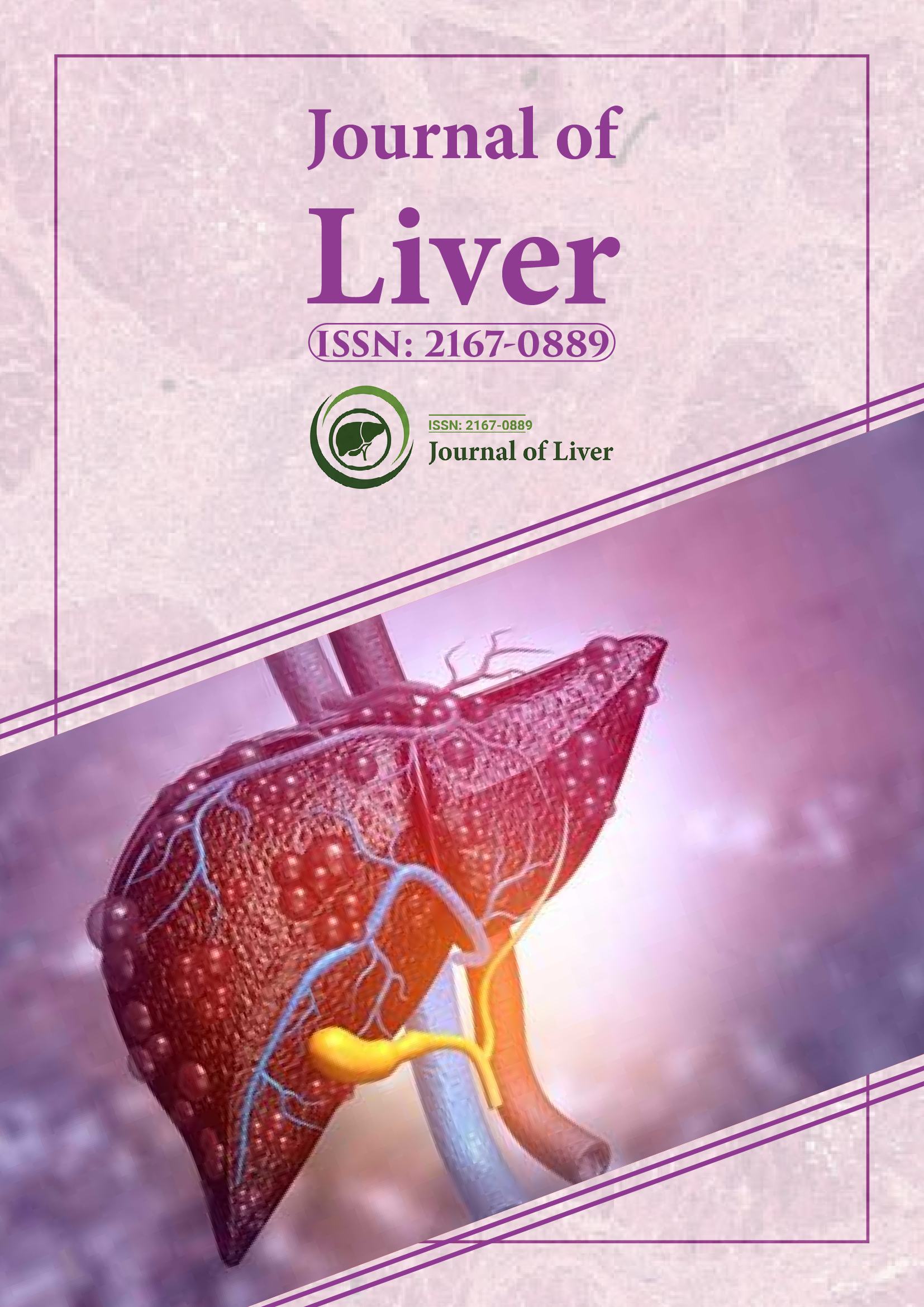Indexed In
- Open J Gate
- Genamics JournalSeek
- Academic Keys
- RefSeek
- Hamdard University
- EBSCO A-Z
- OCLC- WorldCat
- Publons
- Geneva Foundation for Medical Education and Research
- Google Scholar
Useful Links
Share This Page
Journal Flyer

Open Access Journals
- Agri and Aquaculture
- Biochemistry
- Bioinformatics & Systems Biology
- Business & Management
- Chemistry
- Clinical Sciences
- Engineering
- Food & Nutrition
- General Science
- Genetics & Molecular Biology
- Immunology & Microbiology
- Medical Sciences
- Neuroscience & Psychology
- Nursing & Health Care
- Pharmaceutical Sciences
Perspective - (2025) Volume 14, Issue 2
Monitoring liver fibrosis and improving outcomes in young patients
Katri Lindros*Received: 26-May-2025, Manuscript No. JLR-25-29525 ; Editor assigned: 28-May-2025, Pre QC No. JLR-25-29525 (PQ); Reviewed: 11-Jun-2025, QC No. JLR-25-29525 ; Revised: 18-Jun-2025, Manuscript No. JLR-25-29525 (R); Published: 25-Jun-2025, DOI: 10.35248/2167-0889.25.14.256
Description
Biliary atresia is a severe neonatal cholangiopathy characterized by obstruction or absence of the extrahepatic bile ducts, often leading to progressive liver fibrosis, cirrhosis and liver failure if left untreated. Early identification of liver fibrosis and timely intervention are critical for improving long-term outcomes. This article reviews current approaches to predicting fibrosis progression, evaluates diagnostic and monitoring tools and summarizes contemporary strategies for management, including surgical, pharmacological and supportive care interventions. Insights from clinical studies and registry data are integrated to provide a comprehensive understanding of disease management in biliary atresia.
Biliary atresia represents a rare but serious hepatobiliary disorder in infants, with an incidence of approximately 1 in 10,000 to 15,000 live births. The condition is characterized by inflammatory obliteration of the bile ducts, which leads to cholestasis, impaired bile flow and subsequent hepatocellular injury. Persistent obstruction triggers progressive deposition of extracellular matrix in the liver, resulting in fibrosis and cirrhosis.
The natural course of biliary atresia is variable, with some infants showing rapid fibrosis progression and early liver failure, while others demonstrate slower disease evolution. The degree of fibrosis at presentation, along with the timing of surgical intervention, largely determines long-term outcomes. Predicting the rate of fibrosis progression can inform clinical decision-making and guide monitoring strategies.
Effective management requires a multidisciplinary approach, combining surgical intervention, supportive medical therapy and close monitoring of liver function and structural integrity. Early diagnosis and assessment of fibrosis severity allow for timely intervention and improved survival with native liver.
Clinical predictors
Several clinical features are associated with accelerated fibrosis in biliary atresia. Delayed diagnosis beyond 60 days of life is consistently associated with more advanced fibrosis at the time of surgery. Persistent jaundice, pale stools, hepatomegaly and elevated liver enzymes provide indirect evidence of ongoing cholestatic injury.
Growth parameters also serve as indicators, as infants with progressive fibrosis often demonstrate failure to thrive. Additionally, the presence of portal hypertension signs, such as splenomegaly or thrombocytopenia, may reflect significant fibrosis and cirrhosis.
Imaging techniques
Noninvasive imaging plays an increasingly important role in assessing liver fibrosis. Ultrasound elastography allows estimation of liver stiffness, which correlates with fibrosis severity. Magnetic Resonance Elastography (MRE) provides a more detailed evaluation of liver tissue mechanics and can quantify fibrosis with higher precision. Serial imaging enables monitoring of disease progression and the impact of interventions.
Conventional imaging modalities, including ultrasonography and MRI, can identify structural changes, biliary tract abnormalities and complications such as portal hypertension or cirrhosis. However, imaging alone may not capture early fibrosis and it is often complemented by biochemical markers and histological assessment.
Liver biopsy
Liver biopsy remains the reference standard for fibrosis evaluation. Histological examination provides direct assessment of collagen deposition, architectural disruption and inflammatory activity. The METAVIR and Ishak scoring systems are widely used for fibrosis staging.
While biopsy is invasive, it offers precise evaluation and can guide surgical planning, especially in cases where noninvasive markers provide uncertain results. Repeat biopsy may be considered to monitor fibrosis progression postoperatively.
Pharmacological and supportive therapy
Postoperative medical management aims to reduce cholestatic injury and support liver function. Ursodeoxycholic Acid (UDCA) is commonly administered to improve bile flow and reduce bile acid toxicity. Fat-soluble vitamin supplementation (A, D, E, K) is essential due to malabsorption caused by cholestasis.
Emerging therapies under investigation include antifibrotic agents, antioxidants and modulators of inflammatory pathways. While clinical evidence remains limited, these interventions may offer adjunctive benefits in slowing fibrosis progression.
Nutritional support is critical, as adequate caloric and protein intake supports growth, liver regeneration and immune function. Specialized formulas or enteral supplementation may be required in infants with poor oral intake.
Monitoring and long-term care
Regular follow-up is essential to detect recurrent cholestasis, progression of fibrosis and complications such as portal hypertension, variceal bleeding, or hepatocellular carcinoma. Monitoring includes physical examination, liver function tests, imaging and, when indicated, liver biopsy or elastography.
Patients who progress to cirrhosis or experience liver failure may require liver transplantation. Timing of transplantation depends on the rate of fibrosis progression, clinical deterioration and complications. Early referral to transplant centers is recommended for high-risk patients.
Liver fibrosis in biliary atresia remains a significant determinant of morbidity and long-term outcomes. Early prediction of fibrosis progression using clinical features, imaging, biomarkers and histology allows timely intervention and better planning for supportive and surgical management. Kasai portoenterostomy, combined with postoperative care and monitoring, remains the cornerstone of treatment, yet a substantial proportion of patients progress to cirrhosis and require liver transplantation. Ongoing research into molecular mechanisms, noninvasive diagnostics and therapeutic strategies continues to improve understanding and management of fibrosis in this vulnerable population.
Citation: Lindros K (2025). Monitoring Liver Fibrosis and Improving Outcomes in Young Patients. J Liver. 14:256.
Copyright: © 2025 Lindros K. This is an open-access article distributed under the terms of the Creative Commons Attribution License, which permits unrestricted use, distribution, and reproduction in any medium, provided the original author and source are credited.
